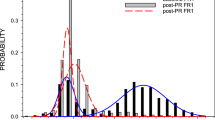Abstract
Operant-conditioning methods were used to train rats to reach through an opening in an operant chamber to exert forces on a silent, neraly isometric force-sensing manipulandum. The reinforcement contingency required the rat to hold forelimb force at 20–50 g for a minimum of 2 s. Once established, this ‘hold-in-the-band’ behavior yielded three measures of performance (time on task, number of reinforcers, variance of in-band force). Variance of in-band force was presumed to reflect steadiness of forelimb control. Acute drug effects on the three dependent variables were assessed for dose ranges of haloperidol (HAL), chlorpromazine (CPZ), clozapine (CLZ), and chlordiazepoxide (CDP). Moreover, the effects of HAL (0.5 mg/kg) and CLZ (5.0 mg/kg) were examined in a subchronic (28 day) dosing regimen. The acutely administered neuroleptics (HAL, CPZ, CLZ) produced dose-related decreases in time on task and number of reinforcers, but did not significantly affect variance of in-band force. The subchronic paradigm produced similar results. CDP did not significantly affect variance of in-band force and the 5.0 mg/kg dose produced a slight, but non-significant increase in time on task while significantly decreasing number of reinforcers; a trend opposite to that seen for the neuroleptics, which produced parallel effects on these two measures. The results suggest that the neuroleptics impaired performance by affecting the tendency to initiate responding instead of affecting the capacity to maintain steady forelimb force once a response was started.
Similar content being viewed by others
References
Beninger RJ, Hahn BL (1983) Pimozide blocks establishment but not expression of amphetamine-produced environment-specific conditioning. Science 220:1304–1306
Beninger RJ, Mason ST, Phillips AG, Fibiger HC (1980) The use of conditioned suppression to evaluate the nature of neuroleptic-induced avoidance deficits. J Pharmacol Exp Ther 213:623–627
Butcher LL, Gan J (1974) Effects on precise motor responding of bilateral intrastriatal application of dopamine. Behav Biol 12:533–539
Butcher LL, Hodge GK, Bryan GK, Eastgate SM (1973) Effects on precise motor responding of bilateral 6-hydroxydopamine infusion into the substantia nigra. In: Usdin E, Snyder S (eds) Frontiers of catecholamine research, Pergamon, New York, pp 763–766
Clark R, Jackson JA, Brady JV (1962) Drug effects on lever positioning behavior. Science 135:1132–1133
Collins P, Lee I, Tyrer P (1979) Finger tremor and extrapyramidal side effects of neuroleptic drugs. Br J Psychiatry 134:488–493
Costall BG, Naylor RL (1975) Detection of the neuroleptic properties of clozapine, sulpuride and thioridazine. Psychopharmacology 43:69–74
DeRyck M, Schallert T, Teitelbaum P (1980) Morphine versus haloperidol catalepsy in the rat: A behavioral analysis of postural support mechanisms. Brain Res 210:143–172
Dunstan R, Broekkamp CL, Lloyd KG (1981) Involvement of caudate nucleus, amygdala or reticular formation in neuroleptic and narcotic catalepsy. Pharmacol Biochem Behav 14:169–174
Evarts EV (1974) Sensorimotor cortex activity associated with movements triggered by visual as compared to somesthetic inputs. In: Schmitt FO, Worden FG (eds) The neurosciences third study program. MIT Press, Cambridge, pp 327–337
Falk JL (1969) Drug effects on discriminitive motor control. Physiol Behav 4:421–427
Faustman WO, Fowler SC (1982) An examination of methodological refinements, clozapine and fluphenazine in the anhedonia paradigm. Pharmacol Biochem Behav 17:987–993
Faustman WO, Fowler SC (1981) Use of operant response duration to distinguish the effects of haloperidol from nonreward. Pharmacol Biochem Behav 15:327–329
Faustman W, Fowler S, Walker C (1981) Time course of chronic haloperidol and clozapine upon operant rate and duration. Eur J Pharmacol 70:65–70
Fibiger HC, Carter DA, Phillips AG (1976) Decreased intracranial self-stimulation after neuroleptics or 6-hydroxydopamine: Evidence for mediation by motor deficits rather than by reduced reward. Psychopharmacology 47:21–27
Ford KE, Fowler SC, Nail GL (1979) Effects of clozapine and chlorpromazine upon operant response measures in rats. Pharmacol Biochem Behav 11:239–241
Fowler SC, Filewich RJ, Leberer MR (1977a) Drug effects upon force and duration of response during fixed-ratio performance in rats. Pharmacol Biochem Behav 6:421–426
Fowler SC, Filewich RJ, Leberer MR (1977b) Within response variations accompanying differentiation of duration in rats. Psychol Rep 40:1271–1284
Jenkins HM, Watts DG (1968) Spectral analysis and its applications. Holden Day, San Francisco
Johanson CE, Aigner TG, Seiden LS, Schuster CR (1979) The effects of methamphetamine on fine motor control in rhesus monkeys. Pharmacol Biochem Behav 11:273–278
McMillan DE, Leander JD (1976) Effects of drugs on schedule controlled behavior. In: Glick SD, Goldfarb J (eds) Behavioral pharmacology. Mosby, Saint Louis
Niemeggers CJE, Verbreggen FJ, Janssen PAJ (1974) The influence of various neuroleptic drugs on shock avoidance responding in rats. In: Fielding S, Lal H (eds) Neuroleptics. Futura, New York, pp 76–97
Posluns D (1962) An analysis of chlorpromazine-induced suppression of avoidance response. Psychopharmacologia 3:361–373
Samson HH, Falk JL (1974) Ethanol and discrimintive motor control: Effects on normal and dependent animals. Pharmacol Biochem Behav 2:791–801
Simpson GM, Angus JWS (1970) A rating scale for extrapyramidal side-effects. Acta Psychiatr Scand 212:11–19
Sovner R, DiMascio A (1978) Extrapyramidal syndromes and other neurological side effects of psychotic drugs. In: Lipton MA, DiMascio A, Killam KF (eds) Psychopharmacology: A generation of progress. Raven, New York, pp 1021–1032
Stiles RN, Pozos RS (1976) A mechanical reflex oscillator hypothesis for parkinsonian hand tremor. J Appl Physiol 40:990–998
Sutton D, Taylor EM (1972) Role of visual cueing in force discrimination by monkeys. Physiol Behav 8:677–681
Wise RA (1982) Neuroleptics and operant behavior: The anhedonia hypothesis. Behav Brain Sci 5:39–53
Wood RW, Weiss AB, Weiss B (1973) Hand tremor induced by industrial exposure to inorganic mercury. Arch Environ Health 26:249–252
Author information
Authors and Affiliations
Rights and permissions
About this article
Cite this article
Fowler, S.C., Ford, K.E., Gramling, S.E. et al. Acute and subchronic effects of neuroleptics on quantitative measures of discriminative motor control in rats. Psychopharmacology 84, 368–373 (1984). https://doi.org/10.1007/BF00555215
Received:
Accepted:
Issue Date:
DOI: https://doi.org/10.1007/BF00555215




